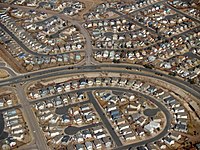
Photo from wikipedia
Type-2 diabetes, which has emerged as a global epidemic in recent years, is strongly related to lifestyle and economic change. The built environment (BE) influences lifestyle factors such as physical… Click to show full abstract
Type-2 diabetes, which has emerged as a global epidemic in recent years, is strongly related to lifestyle and economic change. The built environment (BE) influences lifestyle factors such as physical activity and diet. Evidence shows that individuals who live in neighbourhoods with the availability of destinations for physical activity within walking/cycling distance are more likely to engage in the same and thereby improve their health. Walking can be increased in neighbourhoods by providing useable and unencroached pedestrian pathways, undertaking motor-traffic reduction strategies, improved perceived neighbourhood safety, increasing good street connectivity, parks, green space, playgrounds and recreation areas. Thus for the BE to positively influence health outcomes and be made more activity-friendly, requires combined efforts of health professionals and stakeholders in the Government as well as the private sector.
Journal Title: Current Science
Year Published: 2017
Link to full text (if available)
Share on Social Media: Sign Up to like & get
recommendations!